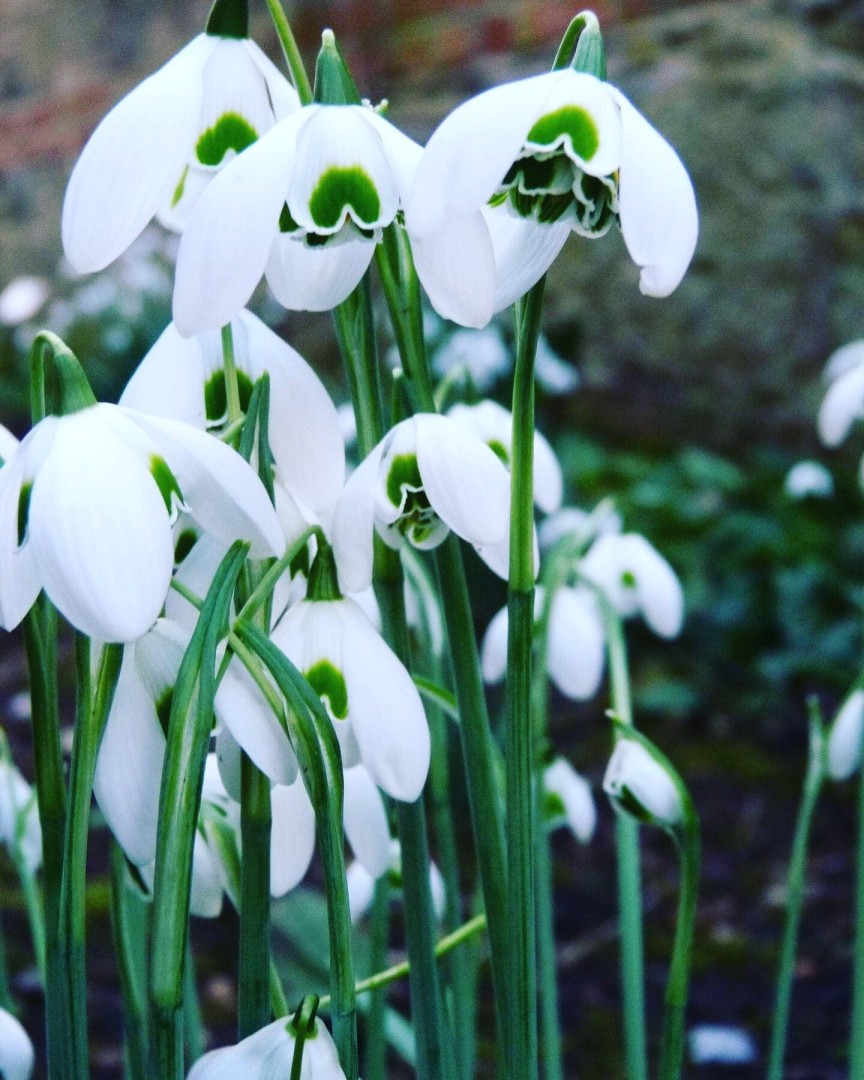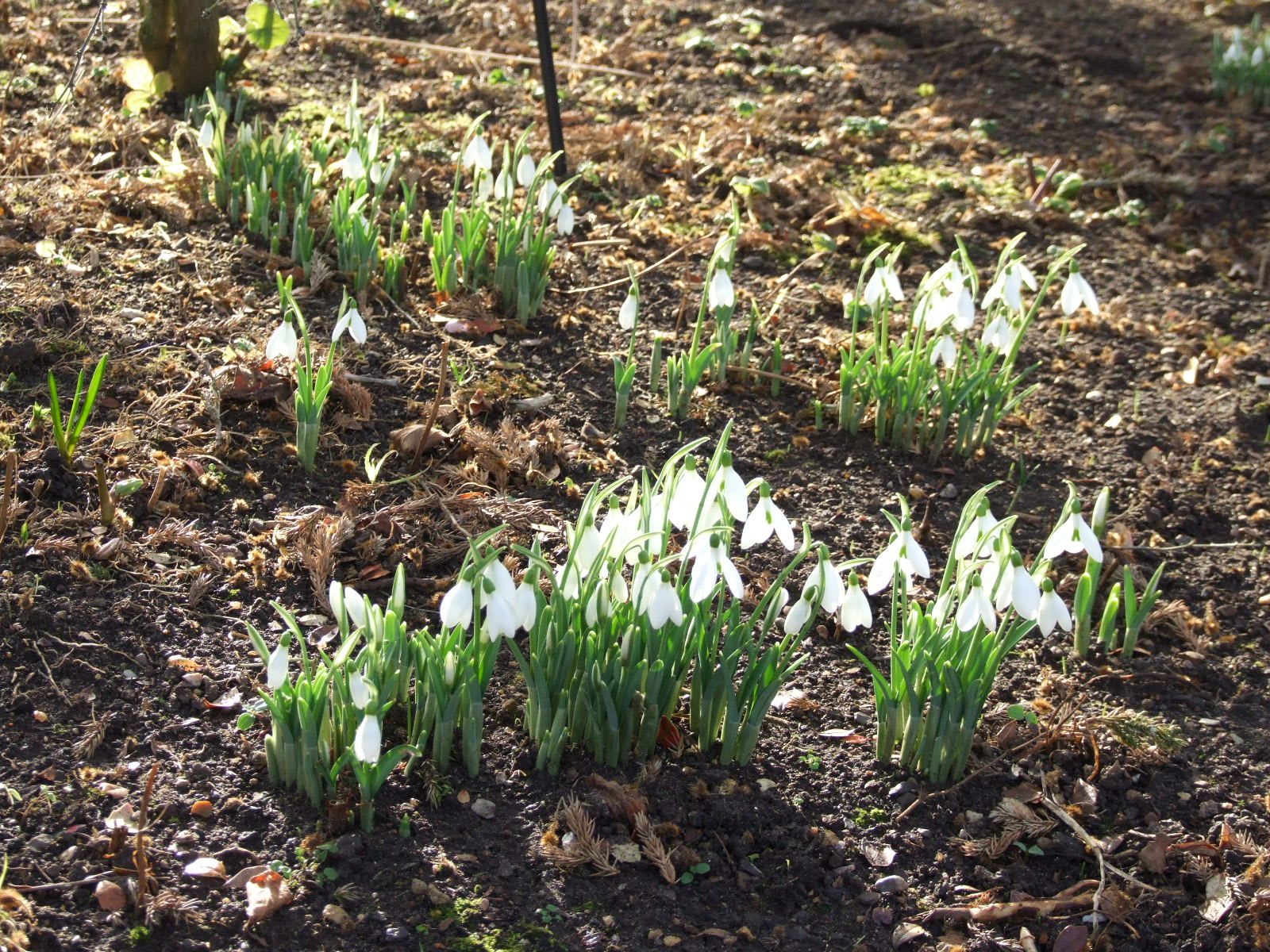For me, seeing the first shoots of the snowdrops coming through the grass or soil fills my heart with joy as I know spring will soon be upon us. There was a time when their beautiful white flowerheads did not appear until well into February, flowering into March. However, as our winters get milder, teardrops of white can appear early in the New Year – in fact, snowdrops are the official flower for those with January birthdays.
Native to Central and Southern Europe, snowdrops are thought to have been brought to this country by the Romans with the first reference to their cultivation made by John Gerard in 1597. Nowadays they are widely found throughout the United Kingdom with many Oxfordshire gardens giving forth glorious displays in the spring. Their Latin name is Galanthus nivalis meaning ‘milk flower of the snow’; named by Swedish botanist responsible for creating the binomial system of naming plants and animals, Carl Linnaeus, in 1753.
 Like many plants, snowdrops have many myths and symbolism associated with them. As they are often found growing in cemeteries and around gravesites, they are associated with sympathy and consolation. The pure white of their petals also symbolises innocence and purity and – given they are one of the first flowers to bloom in spring – they also symbolise hope.
Like many plants, snowdrops have many myths and symbolism associated with them. As they are often found growing in cemeteries and around gravesites, they are associated with sympathy and consolation. The pure white of their petals also symbolises innocence and purity and – given they are one of the first flowers to bloom in spring – they also symbolise hope.
Whilst the flowers are particularly pretty and dainty, snowdrops are from the Amaryllidaceae family and like daffodils, they are extremely toxic to both humans and our pets. They also contain a naturally occurring substance, Galantamine, which has been used to create a medication to help treat the symptoms of Alzheimer’s disease since it received NICE approval in 2010.
Planting Snowdrops
These flowers grow best when planted in humus-rich, moist but well-drained soil in light, in dappled shade unless you are looking to plant the more unusual autumn flowering varieties. Consider siting them under trees and shrubs which will act as a canopy. Autumn varieties such as Galanthus ‘Barnes’ require a sunny spot and a good layer of grit and sand under the bulb as they do not like to sit in wet soil.
Traditionally snowdrop bulbs were sold once they had finished flowering but were still ‘in the green’, to be planted in the spring. However, you will find dried snowdrop bulbs available to plant in October or November. If you have heavy clay soil, add sand or grit to improve drainage and incorporate some well-rotted garden compost to the planting hole. The planting hole needs to be 10-15 cm deep, planting six to eight bulbs in each hole. If you are planting snowdrops with their leaves ‘in the green’, do not be tempted to cut the leaves back. Instead let them die back naturally to allow the goodness to be absorbed back into the bulbs, feeding next year’s buds.
When it comes to selecting your bulbs, you have around 20 species and more than 2,500 recognised varieties or cultivars to choose from. The flower heads can be single with one layer of petals, or double with multiple layers of petals. Many varieties of snowdrop flowers hang down from their stem, like a lantern, with the outer three tepals curved into a tight pointed oval which may appear solid. When temperatures drop severely, the flower heads collapse but will reopen when it warms up again. Their grass-like foliage can be glaucous, vibrant green and even variegated. Natural variations do occur with double flowers and green-tinged petals or differently shaped petals. Many varieties have a pleasing, almost honey-like scent.
As you delve into the different species and varieties of snowdrops, you will begin to realise that building a collection of these exquisite plants can bring much joy to a late winter/early spring garden. Whilst the common snowdrop Galanthus nivalis is relatively inexpensive to buy, rarer forms cost considerably more. Once a new variety has been identified, its propagation is a slow process as they do not reproduce easily. For extremely rare varieties which are in short supply, with many collectors keen to have it in their garden, prices can reach as much as £1,850 as happened when Galanthus plicatus Golden Tears which sold at auction in February 2022.
If you have a particular interest and are keen to become a Galanthophile, you may like to consider joining the Cottage Garden Society where you can also join the Snowdrop Group. Members receive two newsletters annually, a visit to a Snowdrop Day (at extra charge) with snowdrop sales and talks.
For further information please visit thecgs.org.uk/specialist-group-details/snowdrop-group.
Places In and Around Oxfordshire to See Stunning Snowdrops Drifts
Waterperry Gardens near Wheatley has more than 60 different snowdrop varieties carpeting the ornamental gardens, with a spectacular show along the River walk. You will also be able to purchase a selection of varieties and their knowledgeable staff will be on hand to offer advice too. The event runs from the 1 – 28 February.
Kingston Bagpuize House and Gardens is the stunning venue for a Snowdrop and Plant Fair which is held in February.
Thenford Arboretum in Banbury is home to Lord and Lady Heseltine and they have been encouraged by Henry and Carolyn Elwes of Colesbourne Park near Cheltenham, to broaden their collection of snowdrops at Thenford. With snowdrop walks through parts of the garden it is certainly worth visiting. Spring snowdrops can be seen on 2,10, 17 and 21 February 2024.
Welford Park, near Newbury, has one of the finest snowdrop collections in the UK. Growing amongst a five acre beech wood, with enchanting riverbanks of the River Lambourn and the glorious gardens this is the perfect place for a springtime visit.









